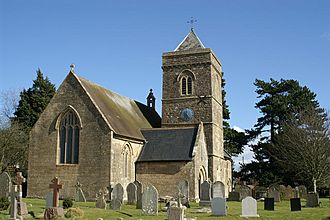Church of St Peter and St Paul, Weston in Gordano facts for kids
Quick facts for kids Church of SS Peter & Paul |
|
|---|---|
 |
|
| General information | |
| Town or city | Weston in Gordano |
| Country | England |
| Coordinates | 51°27′51″N 2°48′07″W / 51.4642°N 2.8020°W |
| Completed | 15th century |
The Church of SS Peter & Paul is an old and important church located in Weston in Gordano, a village in Somerset, England. It's an Anglican church, which means it belongs to the Church of England. This church is so special that it has been given a "Grade I listed building" status. This means it's considered a building of exceptional historical and architectural interest.
Contents
A Look at the Church's History
The church has a long history! Its tall tower and the entrance porch were first built around the year 1300. Most of the other parts of the church were built later, during the 15th century (which is the 1400s). A person named Sir Richard Percivale helped pay for much of this building work. He passed away in 1483, and you can find his tomb inside the church, in the north part of the main area called the nave.
Church Layout and Design
The church building has a main area called a nave, which is divided into four sections, or "bays." It also has a chancel, which is the part of the church near the altar, and a small chapel on the south side. The church's tall tower, which has four levels or "stages," stands at the southern end of the building.
Inside the Church
When you go inside the Church of SS Peter & Paul, you'll find some very old and interesting features.
Ancient Font and Pulpits
One of the oldest items is the original font, which is a large basin used for baptisms. It was made in the Norman style, meaning it's from a very early period of English history. There's also a stone pulpit (a raised stand where sermons are given) that dates back to the 13th century. On the north side of the church, you'll see another pulpit from the Jacobean period, which was in the 1600s.
Special Seats: Misericords
You can also find special seats called misericords. These are small ledges on the underside of folding seats in the choir stalls. When the main seat is folded up, the misericord provides a small support for someone to lean on while standing during long services. These misericords are from the 14th century, but some people think they might be even older, possibly from the 12th century, and were moved here from a place called Portbury Priory.
Church Community
The Church of SS Peter & Paul is part of a group of churches in the area. This group, called a benefice, includes churches from East Clevedon, Clapton in Gordano, Walton Clevedon, Walton in Gordano, and Weston in Gordano. They all work together within the larger Portishead deanery.
See also
- Grade I listed buildings in North Somerset
- List of Somerset towers
- List of ecclesiastical parishes in the Diocese of Bath and Wells

